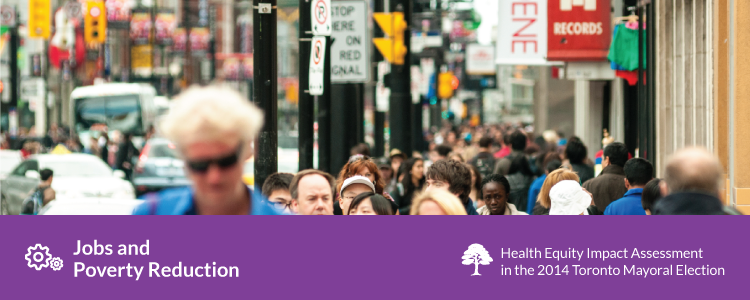Having enough money to meet your basic needs is essential to good health. However, too many Torontonians struggle to make ends meet. In Toronto in 2010, 19.3 percent of the population had income under Statistics Canada’s after-tax low income measure.1 This means that almost 497,000 people in the city were struggling to make ends meet, choosing between rent and groceries, forgoing essential needs for good health for themselves and their families. Poverty rates are even higher for children under six years of age (25.6 percent) and youth aged under 18 years (25 percent).
Poverty is experienced differently for some communities; racialized communities experience consistently higher rates of poverty. In 2012, 41 percent of Torontonians of Southern and East African origin were living below the low income measure. People of Central and West African and West Central Asian and Middle Eastern origins were also over-represented among those living in poverty. 2
Many factors can contribute to low income. In July 2014, Toronto’s unemployment rate was 8.9 percent – higher than Ontario’s rate of 7.8 percent.3 The situation is particularly amplified for youth in Toronto, with people aged 15-24 experiencing 13.4 percent unemployment.4 Employment in Toronto is also becoming less secure, with only 49.4 percent of people working in Toronto having a permanent, full-time job with benefits.5 At $11 per hour,6 Ontario’s minimum wage is not adequate to afford a decent standard of living in Toronto. Moreover, social assistance rates in Ontario are low, with single people on Ontario Works receiving only $626 per month.7
Living in Toronto is difficult on a low income. Housing costs are high – 43.5 percent of renter households pay more than 30 percent of their income on housing8 – which can mean not having enough money for other essentials like nutritious food or transit to get to work. In 2012, a minimum wage earner supporting a family of four could expect to pay 53 percent of their income on rent and 29 percent on healthy food.9 This means little money – if any – is left at the end of the month for clean clothes, trips to the dentist, or TTC tokens. In April 2014, Toronto City Council voted unanimously to develop a Poverty Reduction Strategy for the city.10
A health-enhancing jobs and income plan would include initiatives to increase the number of well-paying, stable jobs that include benefits and would lay out a plan to reduce poverty in our city.
Health Impacts of Jobs and Income
Having adequate income is a major determinant of good health, and there is extensive evidence that people with low income are at greater risk of a number of serious health conditions. For example, diabetes rates tend to be higher in low income areas and poorer communities experience higher rates of diabetes-related complications.11 Moreover, many of the individual-level interventions that can prevent or control diabetes, such as healthy eating and regular physical exercise, are not possible for low income people owing to affordability barriers.12 In an Ontario study, women in the lowest income group were 2.5 times more likely to have diabetes than women in the highest income group, while men in the lowest income group were twice as likely to have diabetes as men in the highest income group.13 Low income is also associated with increased risk of cardiovascular disease14 and poor mental health, including increased rates of anxiety, depression, psychological distress and suicide.15
In addition to affecting health status, income can also influence life expectancy. Statistics Canada research shows that the difference in life expectancy at age 25 between the highest and lowest income groups was 7.4 years for men and 4.5 years for women. The life expectancy gap reduced at every step up the income ladder: people in the second lowest income group had a longer life expectancy than those in the lowest income group, and so on.16 This means that incremental increases in life expectancy can be made even by raising people up a single income bracket.
Low income can also have health impacts at the neighbourhood level, which can reinforce individual health inequities. Low income neighbourhoods often have fewer community resources, such as recreation centres, access to public transit, and health and family services, than wealthier neighbourhoods. Moreover, low income neighbourhoods may have higher rates of unhealthy behaviours, such as smoking and a lack of physical activity.17 In Ontario, people living in the poorest neighbourhoods reported lower positive mental health (66 percent) compared to those living in the best-off neighbourhoods in the (78 percent).18
Health Equity Impacts of Jobs and Income
Not everybody has equitable access to adequate income and good jobs and, as a result, some populations may be at greater risk of poor health. Women may be especially impacted by low income, especially those raising children in single-parent households. Women may prioritize their children’s needs over their own – for example, by skipping meals so that their children have enough to eat – which can contribute to poor health.19 Despite this, children who grow up in low income households may still be at greater risk of poor health both in childhood and throughout their life.20
Currently in Toronto, young people are experiencing particular challenges in becoming established in the labour market, and the youth unemployment rate is high. Not having a decent job can have health impacts over a lifetime. Being unemployed early in life can contribute to increased risks of cigarette smoking and poor mental health later in life.21 People with disabilities also face significant barriers to labour force participation – 90 percent of people with a serious mental illness are unemployed22 – and may therefore have to rely on public disability programs like ODSP that provide very low levels of income.
In Toronto, there are an increasing number of people working in jobs that do not support good health. The ‘working poor’ are people aged between 18 and 64 with earned income of at least $3,000 per year but who have an after-tax income below Statistics Canada’s Low Income Measure (LIM). In the Toronto Region, this population increased by 42 percent between 2000 and 2005.23 Working poverty can have serious health impacts: Ontario data show that only 49 percent of those who were working poor reported their health as excellent or very good as compared with 66 percent of people who were working and made sufficient incomes.24
Toronto is an expensive city in which to live, especially for minimum wage earners. A recent Wellesley Institute study found that the share of minimum wage earners in Ontario increased from 4.3 percent to 9 percent between 2003 and 2011. The report also found that some populations are more likely than others to work for minimum wage and, consequently, be at greater risk of poor health. Racialized Ontarians (13.2 percent) and recent immigrants (19.1 percent) were more likely than the population as a whole to work for minimum wage.25
How do Toronto’s Leading Mayoral Candidates Measure Up for Equity in Jobs and Income?
 Chow |
 Ford |
 Tory |
|
|---|---|---|---|
| Economic Development |
|
|
|
| Youth Employment |
|
|
|
| Poverty Reduction |
|
|
|
Jobs and Income for a Healthier Toronto
Having adequate income to cover housing, food, transportation and other essential needs is critical to good health. While none of the main mayoral candidates have specifically addressed health in their jobs and poverty reduction platforms, it is possible that some of the proposals could help to improve the health of vulnerable groups in Toronto.
Olivia Chow and John Tory have both made commitments to reducing youth unemployment in Toronto. Tory’s plan involves enhancing the City’s existing partnerships with business and community employment agencies through the Program to Advance Youth Employment (PAYE) program, while Chow has promised to require companies that are awarded large City contracts to hire and train youth and for the City to directly employ more youth through increased apprenticeships and jobs. Chow’s plan to increase public sector employment may have positive health benefits as workers in lower-paid occupations, such as cleaning, food preparation and clerks, are usually better paid in the public sector than in the private sector. Moreover, given that women make up a higher proportion of public sector employees, increasing employment in this sector may have positive gender impacts.26 Tory’s plan to facilitate private sector employment for youth through existing partnerships is important, but care must be taken to ensure that the jobs being created for youth are stable, well-paying and include benefits. Doug Ford has not yet addressed youth unemployment.
Chow and Tory have plans to create jobs in Toronto, but neither appears to have a plan to ensure that the jobs that are created are high-quality and supportive of good health. For example, both have committed to creating a Toronto Music Office to support the development of this sector, but neither has addressed how to make these jobs sustainable and health-enhancing. Employment in creative industries is often precarious, with many short-term contracts.27 While creating jobs in the creative industries may have positive economic benefits for Toronto, these benefits should be accompanied by a plan to ensure that high-quality jobs are created. Doug Ford has not yet addressed job creation.
Chow and Tory have signed the Action on Poverty Pledge, which committed them to support a Toronto Poverty Reduction Strategy that includes action on employment, income support, housing and shelter, community supports, children’s services and public transit.28 While many of the macro levers to reduce poverty rest with the federal and provincial governments, the City can also play a significant role in reducing poverty and its health effects. For many people with low income high-quality and equitable municipal services, like libraries, community centres, and affordable child care, are essential to overall income security. Toronto’s next mayor must champion the city’s Poverty Reduction Strategy. Doug Ford has not yet signed the Action on Poverty Pledge.
Download our Jobs and Poverty Reduction Health Equity Impact Assessment
- City of Toronto, 2011 National Household Survey: Income and Shelter Costs, September 2013. Accessed Aug 15, 2014. http://www1.toronto.ca/City%20Of%20Toronto/Social%20Development,%20Finance%20&%20Administration/Shared%20Content/Demographics/PDFs/Reports/nhs-backgrounder-income-shelter.pdf. ↩
- Alliance for a Poverty-Free Toronto, Children’s Aid Society of Toronto, Colour of Poverty – Colour of Change, Ontario Campaign 200 & Social Planning Toronto, New Data Shows Epidemic Poverty Levels in Toronto, August 27, 2014. Accessed August 29, 2014. http://www.socialplanningtoronto.org/wp-content/uploads/2014/08/Fact-Sheet-New-Poverty-Data-FINAL.pdf. ↩
- Statistics Canada, Table 282-0116 – Labour force survey estimates (LFS), by census metropolitan area based on 2006 census boundaries, 3-month moving average, seasonally adjusted and unadjusted, monthly, CANSIM (database). Accessed August 29, 2014. ↩
- Statistics Canada. Table 282-0087 – Labour force survey estimates (LFS), by sex and age group, seasonally adjusted and unadjusted, monthly, CANSIM (database). Accessed August 29, 2014. ↩
- W. Lewchuk, M. Lafleche, D. Dyson, L. Goldring, A. Meisner, S. Procyk, D. Rosen, J. Shields, P. Viducis & S. Vrankulj, It’s More Than Poverty: Employment Precarity and Household Well-Being, PEPSO, McMaster University, United Way Toronto, 2013. ↩
- Ontario Ministry of Labour, Minimum Wage. Accessed August 29, 2014. . ↩
- Income Security Advocacy Centre, Social Assistance Rates Update and Information on the Ontario Child Benefit, September 2013. Accessed August 29, 2014. http://www.incomesecurity.org/FactsheetsonOWandODSPchangesfromBudget2013.htm. ↩
- City of Toronto, 2011 National Household Survey: Income and Shelter Costs, September 2013. Accessed Aug 15, 2014. http://www1.toronto.ca/City%20Of%20Toronto/Social%20Development,%20Finance%20&%20Administration/Shared%20Content/Demographics/PDFs/Reports/nhs-backgrounder-income-shelter.pdf. ↩
- Toronto Public Health, May 2012 – Nutritious Food Basket Scenarios, 2012. Accessed August 29, 2014. http://www.toronto.ca/legdocs/mmis/2012/hl/bgrd/backgroundfile-49920.pdf. ↩
- City of Toronto, Developing a City of Toronto Poverty Reduction Strategy, City Council Decision 27.9, April 1, 2014. Accessed September 18, 2014. http://app.toronto.ca/tmmis/viewAgendaItemHistory.do?item=2014.CD27.9. ↩
- F.B Pilkington, I. Daiski, T. Bryant, M. Dinca-Panaitescu, S. Dinca-Panaitescu, D. Raphael, ‘The Experience of Living with Diabetes for Low-Income Canadians’, Canadian Journal of Diabetes 34(2), 2010. ↩
- Pilkington et al. ↩
- A.S. Bierman, F. Ahmad, J. Angus, R.H. Glazier, M. Vahabi, C. Damba, J. Dusek, S.K. Shiller, Y. Li, S. Ross, G. Shapiro, D. Manuel, ‘Burden of Illness’, in A.S. Bierman (ed.), Project for an Ontario Women’s Health Evidence-Based Report: Volume 1: Toronto; 2009. ↩
- B. Walton-Moss, L. Samuel, T.H. Nguyen, Y. Commodore-Mensah, M.J. Hayat & S.L. Szanton, ‘Community-Based Cardiovascular Health Interventions in Vulnerable Populations: A Systematic Review’, Journal of Cardiovascular Nursing 29(4), 2014. ↩
- M.W. Manseau, ‘Economic Inequality and Poverty as Social Determinants of Mental Health’, Psychiatric Annals 44(1), 2014. ↩
- C. McIntosh, P. Finès, R. Wilkins & M. Wolfson, ‘Income disparities in health-adjusted life expectancy for Canadian adults, 1991 to 2001’ Health Reports 20(4), 2009: Statistics Canada Catalogue no. 82-003-XPE. ↩
- J. Chen & F. Hou, ‘Neighbourhood low income, income inequality and health in Toronto’, Health Reports 14(2), 2003. ↩
- 2011 Annual Report of the Chief Medical Officer of Health of Ontario to the Legislative Assembly of Ontario, Maintaining the Gains, Moving the Yardstick: Ontario Health Status Report, 2011, Chief Medical Officer of Health of Ontario, 2011. ↩
- P. Attree, ‘Low-income mothers, nutrition and health: a systematic review of qualitative evidence’, Maternal and Child Nutrition 1, 2005; Toronto Public Health, Perspectives of Parenting on a Low Income, Toronto: December 2011. ↩
- N. Spencer, T.M. Thanh & S. Louise, ‘Low Income/Socio-Economic Status in Early Childhood and Physical Health in Later Childhood/Adolescence: A Systematic Review’, Maternal Child Health Journal 17, 2013. ↩
- A. Hammarstrom, A & U. Janlert, ‘Early unemployment can contribute to adult health problems: results from a longitudinal study of school-leavers’, Journal of Epidemiology and Community Health 56(8), 2002. ↩
- Mental Health Commission of Canada, The Aspiring Workforce: Employment and Income for People with Serious Mental Illness, Ottawa: Mental Health Commission of Canada, 2013. ↩
- J. Stapleton, B. Murphy & Y. Xing, The “Working Poor” in the Toronto Region: Who they are, where they live, and how trends are changing, Metcalf Foundation, February 2012. ↩
- S. Block, Rising Inequality, Declining Health: Health Outcomes of the Working Poor, Wellesley Institute, 2013. ↩
- S. Block, Who Is Working For Minimum Wage in Ontario? Toronto: Wellesley Institute, 2013. ↩
- S. Block, Reducing Labour Market Inequality, Three Steps At A Time, Toronto: Wellesley Institute, 2013. ↩
- C. Davis, T. Creutzberg & D. Arthurs, ‘Applying an innovation cluster framework to a creative industry: The case of screen-based media in Ontario’, Innovation: Management, Policy and Practice 11(2), 2009; A. Watson, ‘“Running a studio’s a silly business”: work and employment in the contemporary recording studio sector’, Area 43(3), 2013. ↩
- Alliance for a Poverty-Free Toronto, 2014 Municipal Election Candidate Survey, 2014. Accessed September 19, 2014. http://www.socialplanningtoronto.org/wp-content/uploads/2014/08/APTCandidatesPledge2014.pdf. ↩
